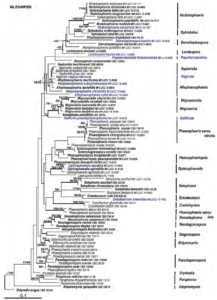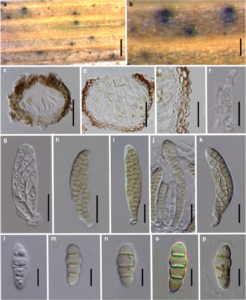Loratospora luzulae Jayasiri, Camporesi & K.D.Hyde.
Index Fungorum Number: IF551325; Facesoffungi number: FoF00882; Fig. 2
Etymology – In reference to host genus.
Holotype – 15-1394
Saprobic on dead stem of Luzula nivea (Juncaceae). Sexual morph: Ascomata 112 – 120 × 93 – 100 μm (x̄ = 98 × 115 μm, n = 5), scattered to clustered, solitary, immersed, visible as small, black spots on the host surface, uni-loculate, globose to subglobose, glabrous, brown to dark brown, ostiole central, with a minute papilla containing hyaline periphyses. Peridium 8 – 20 μm wide, of unequal thickness, thickened at the apex, composed of several layers of brown to dark brown, pseudoparenchymatous cells, arranged in a textura globulosa. Hamathecium of 1.5 – 2 μm wide, septate, long, cellular pseudoparaphyses, embedded in a gelatinous matrix. Asci 64 – 75 × 14 – 16 μm (x̄ = 70 × 15 μm, n = 10), 8 – spored, bitunicate, fissitunicate, short pedicellate, apically rounded and thick-walled, with an ocular chamber. Ascospores 14 – 19 × 4 – 7 μm (x̄ = 16 × 4.6 μm, n = 30), overlapping 2 – 4-seriate, initially hyaline to subhyaline, pale yellowish at maturity, fusiform with rounded ends, 3 – septate, slightly curved, constricted at the septa, wall rough, surrounded by a mucilaginous sheath. Asexual morph: Undetermined.
Culture characteristics – Ascospores germinating on MEA within 36 h. Colonies growing on MEA, slow-growing, reaching 0.5 mm diam. in 1 week at 28 °C. Mycelium superficial, felty, grey.
Material examined – ITALY, Province of Forlì-Cesena [FC], Campigna-Santa Sofia, on dead stems of Luzula nivea (Nathh.) DC (Juncaceae), 8 June 2014, E. Camporesi, IT 1918 (MFLU 15-1394, holotype, BBH), ex-type living culture MFLUCC 14-0826, BCC.
Notes – Loratospora was introduced by Kohlmeyer and Volkmann-Kohlmeyer (1993) as a monotypic genus, with Loratospora aestuarii Kohlm. & Volkm.-Kohlm. Suetrong et al. (2009) transferred Loratospora to Phaeosphaeriaceae based on phylogenetic data, whereas based on morphology it had previously been placed in Planistromellaceae (Barr 1996). This group was not well-resolved in Phookamsak et al. (2014). In this study we introduce a new species to the genus because it is morphologically and phylogenetically different to Loratospora aestuarii. Loratospora luzulae forms a separate branch with Loratospora aestuarii in the phylogenetic analysis (Fig. 1).

Fig. 1 Phylogram generated from maximum likelihood analysis based on combined LSU and ITS sequenced data of Phaeosphaeriaceae. Maximum parsimony and maximum likelihood bootstrap support values greater than 50 % and Bayesian posterior probabilities greater than 0.75 are near the nodes. The ex-type strains are in bold and the new isolates are in blue. The scale bar indicates 0.1 changes. The tree is rooted with Didymella exigua CBS 183.55.

Fig. 2 Loratospora luzulae (holotype) a, b Appearance of ascomata on host surface c, d Section through ascomata e Peridium f Pseudoparaphyses g Immature ascus h – k Mature asci l – p Ascospores. Scale bars: a = 400 μm, b = 100 μm, c, d = 50 μm, e, g – k = 30 μm, l – p, f = 5 μm.
